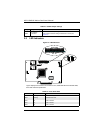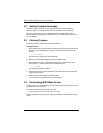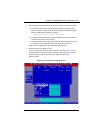
4-1
Chapter 4
MegaRAID BIOS Configuration Utility
The LSI™ MegaRAID® BIOS Configuration Utility (CU) is used to configure disk arrays
and virtual drives and to do other configuration tasks in a pre-boot environment. This
utility is primarily used for SR Mode configurations for the AOC-USAS-L8i Add-on Card.
4-1 Performing a Quick Configuration
The below procedure for quickly configuring arrays and logical drives with the
MegaRAID BIOS CU is intended for users that are already familiar with configuration
utilities and tools. Refer to Section 4-2 for detailed configuration instructions. To ensure
the best performance, select the optimal RAID level for the logical drive you create.
Use the following procedure for quickly configuring arrays and logical drives using the
MegaRAID BIOS CU:
1. Boot the system.
2. Start the MegaRAID BIOS CU by pressing C
TRL+M.
3. Select CONFIGURE from the MANAGEMENT menu.
4. Select a configuration method from the CONFIGURATION menu. You may choose
from either E
ASY CONFIGURATION, NEW CONFIGURATION or VIEW/ADD
C
ONFIGURATION.
5. Create arrays using the available physical drives.
6. Define the logical drive(s) using the space in the arrays.
7. Initialize the new logical drive(s).
4-2 Configuring Arrays and Logical Drives
This section provides instructions for configuring arrays and logical drives with the
MegaRAID BIOS CU.
It is recommended that you use drives with the same capacity when you create a
storage configurations. If you use drives with different capacities in one array, the CU
limits each drive to the capacity of the smallest drive.
The number of physical drives in a specific array determines the possible RAID levels
that you can implement with the array. See Section 2-4: "RAID Minimum Drive
Requirements" on page 2-5 for further details.
WARNING: It is recommended that you do not use both SAS and SATA drives in
the same array. Using different drive interfaces in this way could cause
unpredictable behavior, decreased performance, an increased error count and
decreased Mean Time Between Failures (MTBF).


















